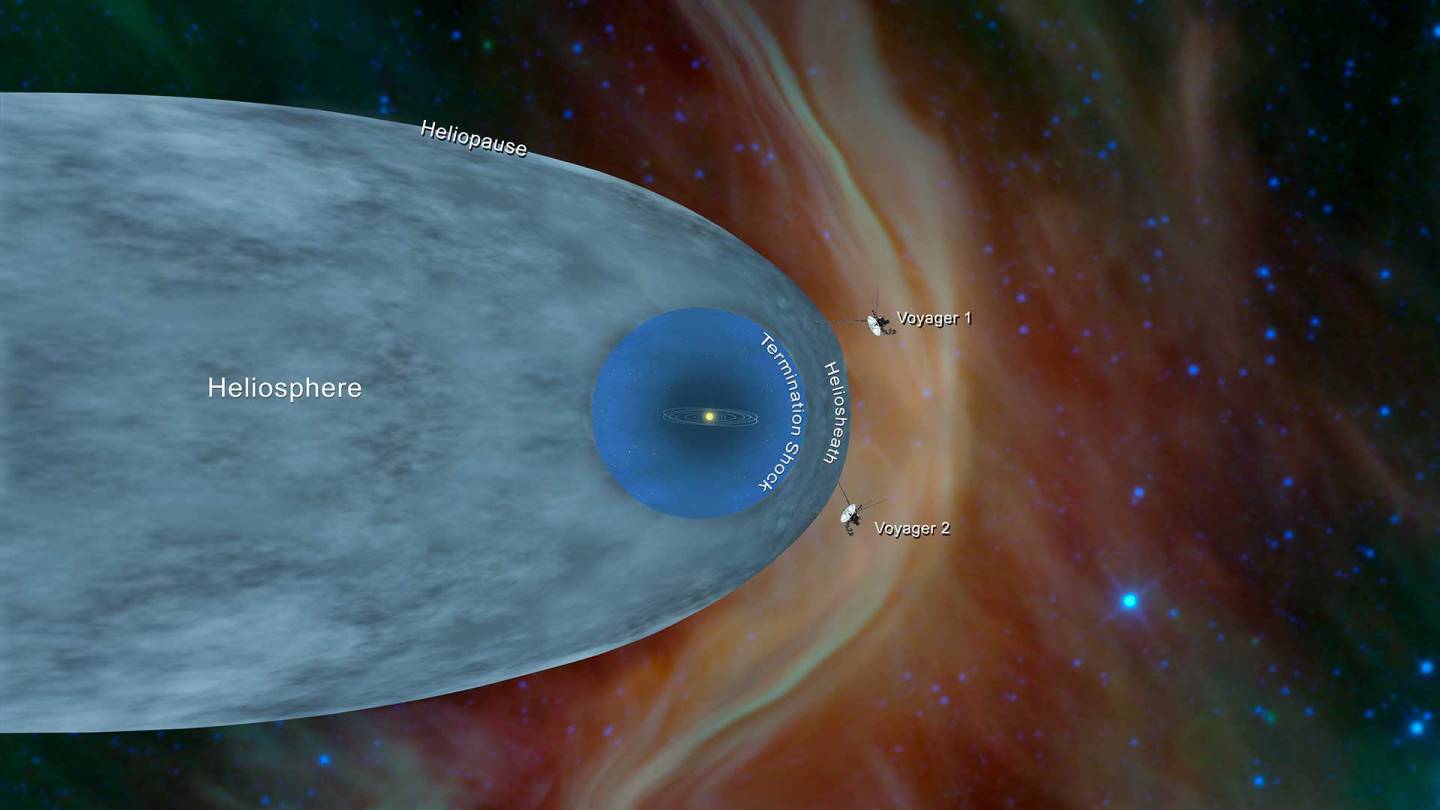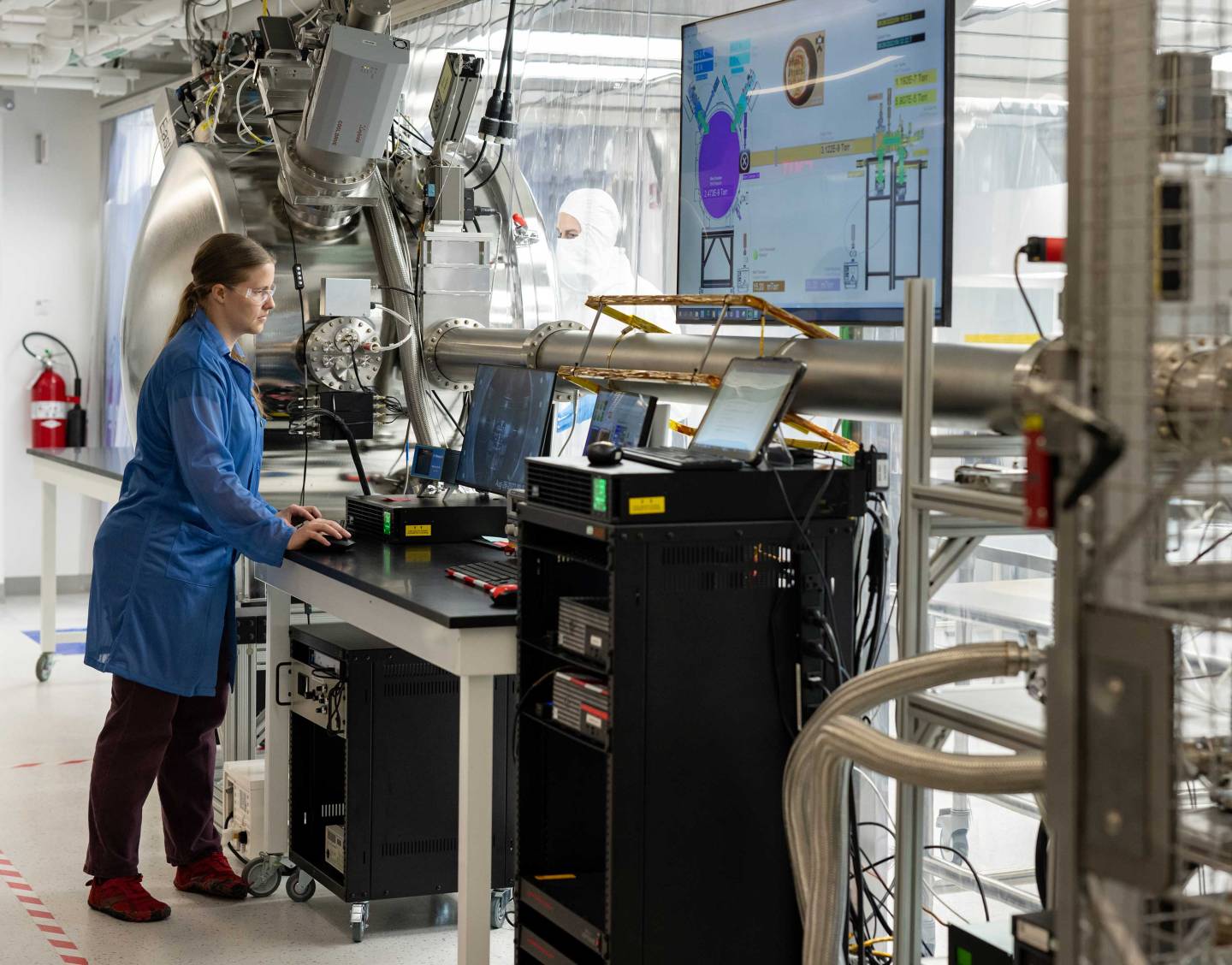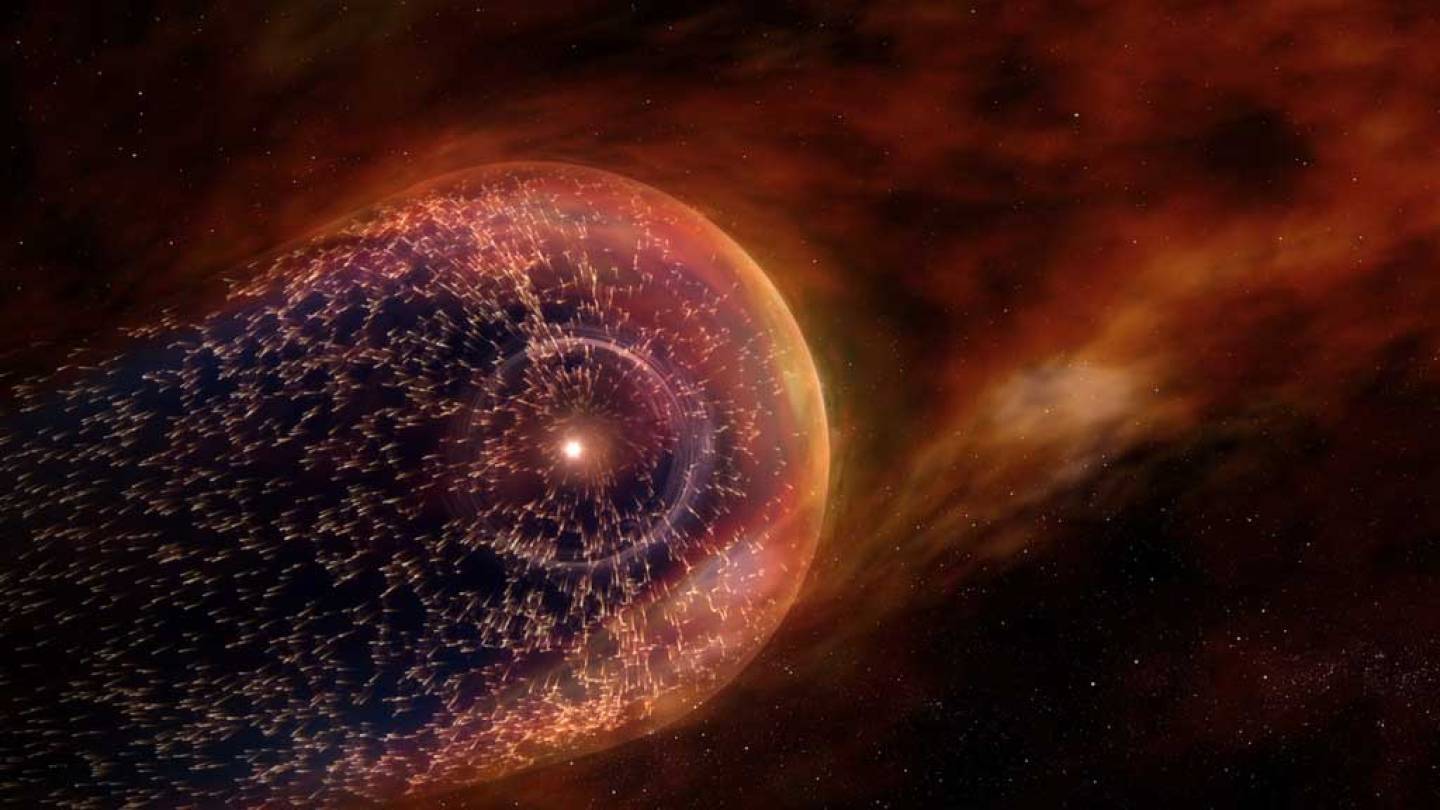The twin Voyager spacecraft captured the public imagination in the 1970s and '80s as Earth's first ambassadors to the outer planets, providing close-up images of Jupiter, Saturn, Uranus and Neptune. Voyager 2 leapt skyward first, on August 17, 1977, followed a few weeks later by Voyager 1 on Sept. 5.
Early career Princeton astrophysicist Jamie Rankin is now playing a leading role on the Voyager team that continues to track the aging probes, each more than 10 billion miles from Earth.
In many ways, the Voyager twins are time capsules of their era. They both carry an eight-track tape player for recording data, they have 3 million times less memory than modern cellphones, and they transmit data about 40,000 times slower than a 5G internet connection. They both have a Golden Record: a message from humanity to the cosmos with greetings in 55 languages, pictures of people and places on Earth, and music ranging from Beethoven to Chuck Berry's "Johnny B. Goode."
In recent decades, the missions have made few headlines, but the little spacecraft have continued voyaging outward under the leadership of Project Scientist Ed Stone. Despite their now-archaic memory and transmission systems, the Voyagers remain on the cutting edge of space exploration as the only instruments to ever travel through interstellar space.
After Stone's recent retirement, Linda Spilker, who has been involved with Voyager since 1977, stepped into Stone's shoes, and Rankin was selected to be the Voyagers' deputy project scientist.
Only 34 years old, Rankin is one of the youngest researchers ever to hold such an elevated title.

Nicola "Nicky" Fox, director of NASA's Heliophysics Division, oversees all solar and heliosphere missions for NASA and participated in selecting Rankin as Voyager's second-ever deputy project scientist.
"Jamie is an absolute rock star," Fox said. "I think it's really important that when you see somebody who's got that much talent, that can do really amazing things, that you give them opportunities."
"Voyager is an amazing mission, and I'm so grateful for this opportunity," said Rankin, who is an associate research scientist at Princeton and an instructor of the space physics laboratory class. "I am only here because I had so many professors and mentors who believed in me; I never expected to make it to a place like Princeton. I can't overstate the importance of mentorship. I love getting to teach students here, and give them opportunities with NASA space flight instrumentation, because I'm so thankful for the opportunities I've been given."
Rankin was Ed Stone's last graduate student at Caltech. He had sworn some 25 years before that he wouldn't take any more grad students, but Rankin lobbied him relentlessly until he took her on.
"I did the first thesis on Voyager's data from interstellar space," Rankin said. "I arrived at Caltech six days after Voyager 1 reached interstellar space, so I got to see that whole history unfold. I entered in thinking about Voyager completely from the interstellar perspective, which was very different than anybody else on the Voyager team, most of whom have been with the mission since the beginning."
"I got to know Jamie when she was a grad student at Caltech, working on my ISʘIS instrument, which is now flying on the Parker Solar Probe," said David McComas, professor of astrophysical sciences and vice president for the Princeton Plasma Physics Laboratory. "I immediately knew that she was the sort of exceptional young experimental physicist that we had to recruit to our Space Physics group at Princeton. Since arriving, Jamie's skills have grown so quickly that in addition to co-teaching our laboratory class, she was able take over leadership of the Solar Wind and Pickup Ion (SWAPI) instrument on IMAP, which is under development to launch in 2025. Jamie has done really exceptional things since joining us and is on track to be one of the new leaders in our field."
Voyager's next generation
"When I walked into the Voyager team room, my first day as a graduate student, I noticed there was at least a three-decade age difference between me and the youngest person in the room," Rankin said. "And when I started as a graduate student, there was a 50-year age difference between me and Ed. We skipped a generation there. But what's really neat about it is that for future space missions, if people want to send an instrument very far away, they absolutely have to have a multi-generational team. With the Voyagers, they just didn't know; no one anticipated the mission surviving this long."
Two years after their 1977 launch, the twin probes flew by Jupiter, beginning the planetary encounters for which Voyager is best known. Both spacecraft visited Jupiter and Saturn, then Voyager 1 headed out of the solar system while the slightly slower Voyager 2 headed on to Uranus and Neptune.
All the planetary encounters were over within 10 years, and on Jan. 1, 1990, the Voyager Interstellar Mission officially began - even though the Voyagers wouldn't technically be in interstellar space until they exited the heliosphere, the bubble of space around our sun.
Two quiet decades after leaving behind the outer planets, Voyager 1 crossed the heliopause in August 2012. Its slower twin crossed that boundary six years later, in November 2018.
The sun is a thermonuclear fireball constantly erupting high-energy particles. As those particles push outwards in all directions, they pour through the solar system, pushing the sun's influence far, far beyond the planets, until they bump up against interstellar particles. The spherical(ish) inner boundary is called the termination shock; past that is the heliosheath, a broad transition zone with both solar wind particles and interstellar medium. Further out, the boundary with pure interstellar space is called the heliopause, or the heliosphere boundary.
Mapping the edge of the solar system
"This is just an incredible time to be studying the outer heliosphere," said NASA's Fox. "For the first time, we have a lot of assets focused on the outer heliosphere."
Fox cited the IBEX mission, headed by McComas, which has spent years imaging the outer edge of the solar system; New Horizons, which has long passed Pluto and is closing in on the termination shock; IMAP, also headed by McComas, which will map the heliosphere in detail; and of course the Voyagers, the only spacecraft ever to venture so far away from our sun.
"The science still coming from the Voyagers is amazing - and underappreciated," said Rankin. "Everything - everything - that we've measured in space gets filtered through the solar wind - through the sun and its plasma and magnetic fields. And everything measured from Earth-based telescopes is also filtered through our atmosphere.
"The very first time that we could measure space directly, without being disturbed by the sun, was when Voyager crossed into the interstellar medium."
One thing Voyager measured was the level of incoming radiation, which was almost 10 times higher outside the heliosphere than inside the bubble. That radiation could pose a deadly threat to astronauts, but the Voyagers showed that the sun, via the solar wind and heliosphere, is filtering out as much as 90% of the interstellar radiation.
"The solar wind is actually protecting us," Rankin said. "Before the Voyagers got out here, nobody knew quite how much we were being shielded."
The Voyagers also discovered that the sun interacts with its boundary differently than scientists had expected. "When two magnetized plasmas meet, it's like north-north magnets - they can't ever mix," Rankin explained. "So the solar plasma, the solar wind, can't mingle with the interstellar plasma. But there are also neutral particles out there that aren't electrified, so they don't care, they just pass straight through the heliospheric boundaries, unaware. Eventually those do have an influence on our solar environment, and our environment can have an influence on them." Although the Voyagers are not equipped to measure these neutral particles directly, other missions, like IBEX and New Horizons have provided complementary insights about the nature of these unique interactions throughout the heliosphere.
When IMAP launches in 2025, it will map out that elusive boundary zone in great detail, providing a comprehensive picture to complement the deep but geographically limited data that the two Voyagers have collected.
What does a project scientist - or her deputy - do?

Rankin works in Princeton's space physics laboratory.
NASA's enormous array of spacecraft missions generally fall into two categories: Smaller missions that are run by a single principal investigator (nearly always shortened to PI), and larger missions that have PIs for each of their instruments. McComas, for example, in addition to being Princeton's vice president for the Princeton Plasma Physics Lab and a professor of astrophysical sciences, is the PI for many missions and instruments, including both the IBEX and IMAP missions and the ISʘIS instrument suite on the Parker Solar Probe.
The large missions have a project scientist (and sometimes a deputy) to coordinate the mission's many-fold research endeavors, to make sure the different instrument PIs don't become too siloed in their thinking, and to provide leadership.
"Currently on Voyager, what that looks like is making some tough calls," said Rankin. "These are aging spacecraft, and we want to keep the mission running as long as possible. But they're in completely new territory, both geographically and in the sense that these are the first spacecraft that have been operating for this long. They just celebrated their 45th launch anniversaries. So how they age, and how long can they keep going - that is all critical to prioritize the science that is left."
The Voyagers are powered by plutonium-238, which has a half-life of 88 years. "That seemed like forever when they launched, but now we're more than halfway through that half-life, and there's not much base power to operate the spacecraft," Rankin said. "The Voyager teams already shut down some of the instruments - they turned off the cameras with the end of the planetary mission - and I saw Ed lead the Voyager team to a consensus decision to start turning off the heaters to the remaining instruments. Nobody knew if the instruments could operate without the heaters, but the choice was either turn off more instruments, turn off the heaters, or lose the spacecraft. What do you do?"
Fortunately, the instruments have continued to generate and transmit data as the heaters have been shut down, one by one.
The aging spacecraft also have nowhere near the transmission power needed to send a clear signal across the billions of miles back to Earth, which means that Earth-based telescopes have had to work harder and harder to detect their faint signals.
"Ed once described it to me as a blinking refrigerator light bulb in space," said Rankin. "That's the kind of signal strength we're talking about. So we have to have heroic efforts on the ground to communicate with them. If the advancements on Earth hadn't happened - including building 70-meter dishes for the Deep Space Network - we wouldn't have been able to keep communicating with the Voyagers as they got further and further away."
Voyager's continuing mission, to boldly go where no spacecraft have gone before - and look back
Voyager 1 is now billions of miles outside the heliopause, as far from that boundary as Neptune is from Earth, and speeding onward at about a million miles a day.
And it's still making remarkable discoveries, said Rankin. "Even at that distance, it still sees effects from the sun. When solar flares or coronal mass ejections erupt from the sun, they travel through the solar system, and it turns out they can pile up and merge into giant events that actually reach all the way to the heliopause and then shove against that boundary - and then that sends ripples into interstellar space. And Voyager can see it."
The Voyagers' distance also gives them a completely different perspective on Earth and the sun. "Voyager allows us, for the first time, to look at our own star and our own planetary system from the outside," Rankin said. "For decades, we've looked at other stars from the outside, and gathered remote data, but all that we knew about our own star was 'from the inside,' so to speak. So, what do we look like from the outside? The only way to know is to have a spacecraft out there - or, better yet, two spacecraft at different locations."







